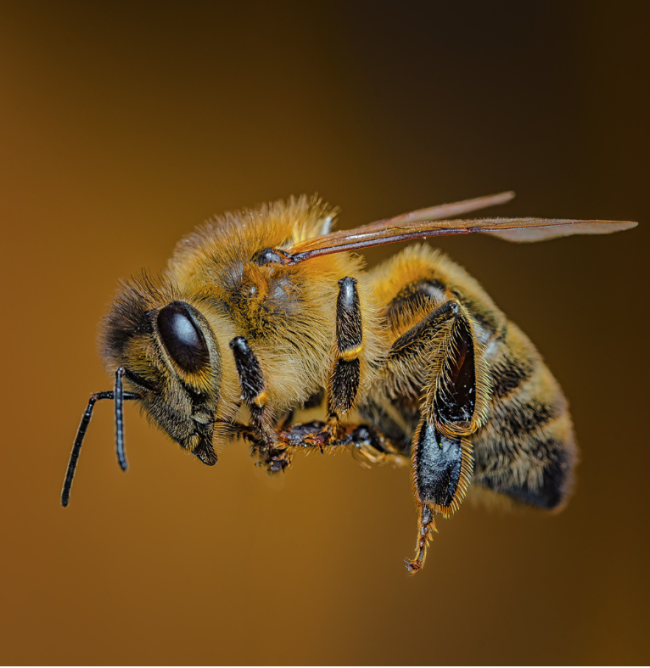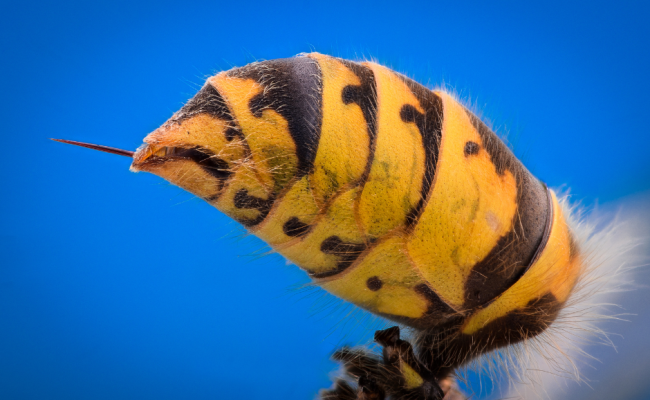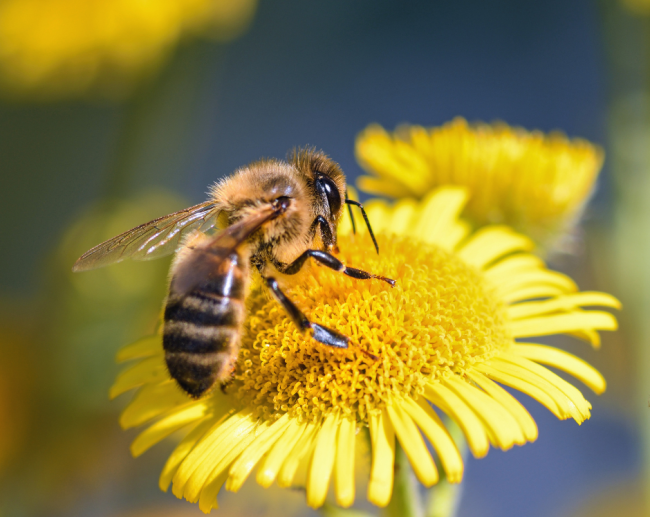Why Do Bees Die After Stinging?
Why do bees die after stinging? Do all of them die or just a specific kind of bee? We’re about to find out!

Why Do Bees Die After Stinging? Does it always happen?
It’s a story many of us grew up hearing or even experienced on our own skin. A bee uses its stinger, and then, sadly, it dies. But why does this happen? Is it some sort of kamikaze mission for the greater good of the hive?
In this article, we’re going to dive deep into the biology behind this curious phenomenon. You’ll find out why some bees pay the ultimate price for that little sting. Stick around; it’s going to be a buzzworthy conversation!
1. The bee’s stinger is like a harpoon
So, think of the honeybee’s stinger as nature’s version of a hypodermic needle—hollow and super sharp. According to experts, this stinger isn’t just a simple point; it’s decked out with two rows of what you could call mini-blades. And these aren’t just any blades; they’re barbed, sort of like fishhooks, facing outward. Imagine the design of a harpoon or two rows of saw-toothed blades, like something straight out of a pirate movie! It’s built to dig in and stay put. Pretty intense, huh?
Now, these barbed stingers are actually evolved for combat with other insects and bees, not for us mammals with thick skin. When they sting us, that’s when things get tricky for them. The barbs on the stinger get stuck in our skin, like a harpoon lodged in a ship.
So, what happens next is kinda heartbreaking. In an attempt to fly away, the bee ends up ripping out a part of its own abdomen and internal organs. Ouch, right? Though bees don’t have blood as we do, they basically bleed to death within a few minutes. It’s a fatal move, all because their stinger got caught. So the next time you hear about a bee’s sting being its last act, just remember: it’s like a harpoon that anchors them to a fate they can’t escape.
2. Why do bees die after stinging? They do everything to protect the hive
So, imagine this—when a bee stings you, it’s not just causing you pain; it’s actually sending out a full-on “mayday” signal to its buddies. Near its sting chamber, there’s a gland that releases alarm pheromones. This is the bee’s way of yelling, “Intruder alert!”.
And let me tell you, the other bees in the hive really listen up. They open their mandibles wide, protrude their stingers, and they’re ready to take on whatever comes close.
Furthermore, as we were pointing out before, the stinger is not just a pointy end; it’s actually connected to a venom sac. This sac pumps a cell-destroying toxin into your skin. And guess what? That toxin smells like bananas. Yeah, bananas! But this scent isn’t a tropical invitation, it’s what gets your skin burning and itching at the same time. And for some people with allergies, it can be fatal.
And because the stinger works like a screw anchor—once it’s in, it’s in for good – the venom keeps pumping into you even after the bee has buzzed off, literally tearing itself apart to do so. It’s a one-way ticket for the bee but a powerful message to any would-be hive attackers.
3. The bee stinger has a mind of its own
So, after a bee stings and leaves its stinger behind, that stinger isn’t just sitting idle. Far from it. There’s actually a tiny cluster of nerve cells that’s still in command. First off, those barbed shafts on the stinger—yeah, they keep moving back and forth, digging deeper into your skin. It’s like the stinger’s on a mission to deliver its payload as effectively as possible, even after the bee is dead.

Then, there are these muscular valves connected to a venom sac. They get to work, pumping that potent toxin right into the wound. And get this—it keeps happening for several minutes, even if the bee has already met its unfortunate end. It’s like the bee’s last act is still playing out, long after it’s gone. Kind of eerie, but also fascinating, right?
Now, you might be wondering, “Do all bees go through this?” Nope, it’s a honey bee exclusive. It might seem like a high price for the hive to pay, losing some of its workers, but if it amps up the hive’s defense system? Totally worth it, according to bee logic.
Actually, from an evolutionary perspective, it makes more sense than you’d think. The worker bees don’t reproduce. Their sole purpose is to defend and maintain the hive and assure the perpetuity of the species.
So, the next time you’re around a hive, remember: these tiny warriors are ready to give it all to keep their home safe. It’s like a neighborhood watch, but with way more commitment and…. well …. stingers! Does that answer your question of why do bees die after stinging? It does, but wait, there’s more!
4. Do they know they will die after they sting you?
Actually, no. They don’t know they’re going kamikaze.
As we were saying, a honey bee’s stinger has this barbed ratchet mechanism. It’s designed to go deep into a wound and stay there. But here’s the kicker: this feature didn’t evolve as some sort of “suicide button.” When honey bees sting other insects, they can usually pull their stinger right back out and go on living their bee lives.
The issue arises with us mammals. Our skin is super fibrous, making it tough for the stinger to make an exit once it’s in. So, when the bee tries to fly away, it ends up leaving more than just a stinger behind; it tears open its own abdomen. It’s a devastating consequence, but one the bee isn’t consciously choosing.
And it’s worth noting, honey bees are the only ones meeting this grim fate. As tragic as it is for the individual bee, experts believe the hive considers it an acceptable loss if it means better security against honey raiders. Also, honey bees aren’t naturally aggressive. They’re actually quite timid when they’re away from their hive. You’d really have to either grab one or venture too close to their home to get stung. So next time you see a bee, remember: it’s not out to get you, and stinging is a last-resort measure it would probably rather avoid.
5. Autotomy or the scientific answer to why do bees die after stinging
Autotomy is basically what honey bees do when they sting. They leave behind a part of their body to escape danger or fend off a predator. But the concept is much more complex than that.
Autotomy comes from Greek words meaning “self-severing,” and it’s a pretty nifty defense trick that’s evolved in animals multiple times throughout history.
For lizards, there are actually two types of tail-dropping: intervertebral and intravertebral autotomy. The first happens between the vertebrae, and the second breaks a specific vertebrae itself, thanks to specialized fracture planes.
And get this, some lizards even have skin flaps that fold over the wound to prevent infection. It’s like they have built-in first aid! It’s like humans having to make the super difficult decision of cutting off one arm or leg to survive. For animals, the body is built in such a way that it makes the decision itself.
Now, back to our honeybees. When they sting, their stinger gets so embedded that they end up tearing away a chunk of their abdomen, muscles, venom sac, and more. This is fatal for the bee, but only if it stings something with skin thick enough to trap the stinger, like a mammal. Queen bees, however, have smooth stingers and get to live another day. In the honeybee world, this is their form of autotomy.
As a fascinating side note, male honey bees, or drones, also practice a form of autotomy. During mating, parts of their genitalia get left behind and form a mating plug. Yeah, you heard that right. And sadly, they too die within minutes.
So, from lizards to bees, autotomy is nature’s dramatic way of saying, “Catch me if you can!” but with serious life-or-death stakes.
6. Bee hive hierarchy
A hive’s hierarchy is quite complex and fascinating. It’s a lot more than a mere gathering of buzzing insects. Each hive is essentially a highly organized community of approximately 50,000 bees, each with its own specialized role.
At the center of this community is the queen bee, a crucial figure responsible for laying around 1,500 eggs per day. She leaves the hive only once in her lifetime for the mating flight, making her the reproductive linchpin of the hive. Her role is not by choice but by destiny, determined by her being raised in a specially designed cell and fed a diet rich in “royal jelly.” Should the queen die or slow down in her reproductive duties, the hive’s equilibrium of the hive is disrupted.
Let’s shift our focus to the male drones, whose sole function is to mate with the queen. Though it might seem like a life of leisure, existing solely for reproduction comes with its own set of challenges. Drones cannot fend for themselves; they neither forage for food nor possess stingers for defense. Once they fulfill their singular purpose—mating—they die. And in times of scarcity or during winter months, they’re often expelled from the hive by worker bees.
But the female worker bees do most of the jobs around the hive
But the hive’s true workforce is undoubtedly the female worker bees. They perform an array of essential tasks that keep the hive functioning smoothly. Nurses take care of the larvae, while attendants look after the queen. The workers are also responsible for the cleanliness and maintenance of the hive, clearing out debris and even performing undertaker duties for deceased bees. They’re the hive’s architects as well, constructing and sealing the honeycomb with beeswax.
The foraging worker bees have their own set of responsibilities. They venture out to collect nectar and pollen, often visiting between 50 and 100 flowers in a single foray. Some are specialized in gathering propolis, a resinous substance used for repairing the hive. Finally, we have the hive’s security detail: guard bees, who stand at the ready to protect their home, using their stingers and emitting warning pheromones if danger approaches.
In summary, the beehive is a highly sophisticated and organized habitat where each bee plays a vital role. It’s a fascinating world of cooperation and complexity, functioning with a level of efficiency that’s truly awe-inspiring.
7. Not all bees sting
Many people harbor a fear of bees primarily because they associate these insects with painful stings. However, it’s crucial to understand that not all bees are equipped with the ability to sting, and even those that can are usually not inclined to do so unless they feel threatened or provoked.
Let’s first focus on the “Stingless Bees”. These bees have an almost non-existent stinger, essentially a modified ovipositor, which isn’t functional for defense. They can’t sting you even if they wanted to. These stingless variants primarily inhabit tropical regions.
The narrative gets even more nuanced when we consider the gender aspect. In species that are capable of stinging, like honey bees and bumblebees, it’s only the females that have this capability. Male bees, while they might engage in defensive behaviors, cannot sting. This includes species like the carpenter bees (Xylocopa), which might seem intimidating as they fly towards you. But rest assured, their posturing is purely for show; they’re all bark and no bite—or in this case, no sting.
Bees are not aggressive by nature
Even among the bee species with stinging females, aggressive behavior is not the norm. For instance, bumble bees are relatively docile creatures. If you step on one or handle it clumsily, you might get stung, but they generally don’t attack unprovoked.
It’s also worth noting that swarming honey bees are less inclined to sting. When honey bees swarm, they’re more focused on finding a new nest site for the colony rather than attacking. Nevertheless, it’s always wise to maintain a safe distance from a swarm and definitely not to provoke them.
A fascinating study conducted by entomologist Justin O. Schmidt in 2019 evaluated the pain and toxicity levels of stings from 78 insect species, 18 of which were bees. The results revealed that most solitary bee species barely registered on the pain index. The sting of a tropical large carpenter bee was found to be the most painful among the bee species studied, but the majority were quite benign.
In conclusion, while it’s natural to have concerns about bee stings, understanding the behavior and characteristics of different bee species can alleviate much of the fear. Stinging is not universal among bees, and even those capable of it are generally not looking for an excuse to attack. It’s all about mutual respect and understanding the invaluable role these remarkable insects play in our ecosystem.
8. Why bees are so important for our ecosystem
It’s easy to overlook the humble bee as we go about our daily lives, but these small insects play a monumental role in sustaining our ecosystem—and by extension, us.
Do you enjoy summertime fruits like apples and melons, or vegetables like asparagus and broccoli? If so, you owe a debt of gratitude to bees. These plants depend on the transfer of pollen from the male anther to the female stigma for fertilization. Bees facilitate this as they hop from flower to flower collecting nectar, incidentally pollinating plants in the process. They are tireless workers, pollinating billions of plants annually, including a plethora of agricultural crops. Astonishingly, one in every three bites of food you eat is made possible by pollinators like bees.

Bees’ impact goes beyond cultivated crops; they are essential for the reproduction of many wild plant species. By facilitating the production of seeds, nuts, berries, and fruits, bees offer a lifeline to many wild animals that rely on such foods.
Bees are more than just pollinators; they’re also producers of honey, a rich food source for their colonies during winter months. This nutritious nectar is sought after by humans and various wildlife, including birds and mammals.
Bees help sustain entire ecosystems
In their role as pollinators, bees contribute to the complexity and stability of various ecosystems. They support the growth of an array of plants, which in turn provide food and shelter to a diverse range of animal species. The interconnected ecosystems that bees help sustain are essential for biodiversity.
In summary, bees are a linchpin in not only our agricultural systems but also in the broader ecological networks. Without them, our world would be a much less colorful and nourishing place. So, the next time you step into your garden, consider how you can make it a haven for these incredible creatures.
9. Why are some people allergic to bee stings
A bee sting is not nice, but it’s not the end of the world for most of us. It will bring a mild to moderate discomfort and then pass. But for some people, it can be much worse than that, and that’s why you should be informed about it.
When a bee stings, it injects venom into the skin. This venom contains proteins that, in most cases, merely cause pain and mild irritation. However, for some individuals, these proteins can trigger an allergic reaction. The immune system mistakenly identifies the bee venom as a harmful invader and releases histamines and other chemicals in response. This can cause symptoms that go beyond the typical localized pain and swelling.
For a small percentage of people, bee stings can cause anaphylaxis, a severe and potentially fatal allergic reaction. Symptoms can include difficulty breathing, rapid drop in blood pressure, loss of consciousness, and, in extreme cases, death. Immediate medical attention is critical in such cases.
Anyone can develop an allergy to bee stings, but some factors may increase risk, such as a family history of allergies or a previous allergic reaction to a bee sting. If you’re aware that you’re allergic to bee stings, it’s crucial to carry an EpiPen or other form of emergency epinephrine and to consult a healthcare provider for a comprehensive treatment plan.
